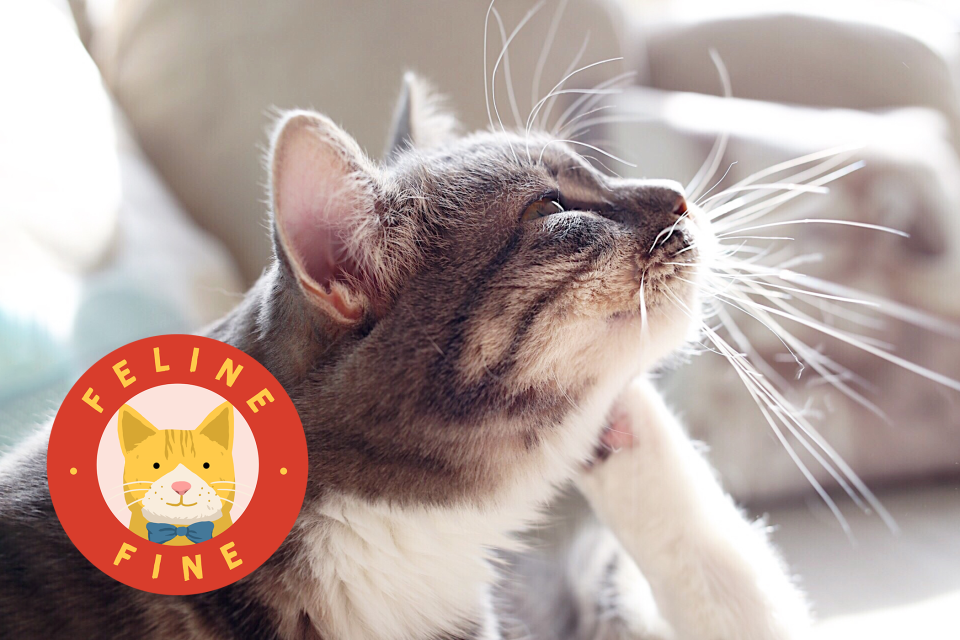Is Cat Lice Common? Here's What You Should Know
Dotdash Meredith and Yahoo Inc. may earn commission or revenue on some items through the links below.
You see the word, and it just makes you cringe. Lice. Ick! Those itchy elementary school days are long gone, so why should you even think twice about these weensy pests, much less about cat lice?
Cat lice is actually a rather rare condition among pampered indoor cats with adoring pet parents and a terrific veterinarian. But if they go outside regularly, or you're the kind of person we admire greatly who's caring for a cat colony or involved with kitty rescue, here's what you should know.

Susanne Alfredsson / EyeEm / Getty
How Can Cats Get Lice?
Good news, cats can't get lice from humans. Better news? We can't get lice from cats, either.
Frank Hurtig, DVM, is the director of veterinary technical services at Virbac US. He says lice are species-specific. "Lice are very particular about the host they'll live on, so the lice that live on cats don't live on other animals and vice versa." Unfortunately, these parasites are highly contagious within the same species.
Hurtig explains the life cycle of cat lice:
Lice attach their eggs to the base of hairs on the cat.
When new lice hatch, they live the rest of their life on that cat unless they happen to brush off to another cat.
Lice eggs can fall off the hairs when a cat is being brushed or combed and be transmitted to another cat that is subsequently brushed or combed.
Adult lice mature and reproduce in about three weeks after hatching from an egg, or nit. They become nymphs and then adults within this timeframe.
(Three weeks! Ick!)
Animal Medical Hospital in Vancouver, B.C. states that lice don't leave their furry abodes willingly, either. "All lice have powerful claws on all six legs, with which they cling to the hair shafts. They're able to hang on tightly enough that even vigorous scratching and biting won't dislodge them."
What Does Cat Lice Look Like?
Hurtig says lice feed two different ways: either by sucking blood or chewing dandruff and tissue debris. Most of us don't have a microscope at home, so we'll just tell you that chewing lice on cats is the norm. You can't see their itty-bitty chompers with the naked eye, but trust us, they've got 'em.
However, Hurtig notes if you look carefully, you can spot lice and their egg clusters. "Lice will most frequently be found around the head and neck, especially underneath a collar," he says. "Lice will be a bit lighter in color than fleas, yellow to tan, and be a similar size—1– to 1–½ mm long."
Aside from color, how else can you tell the difference between cat lice vs. fleas? "Lice look like they got smooshed underneath a stack of books, and they're wider side-to-side and thinner top to bottom," Hurtig says. "Fleas kind of look like they got squished between books standing up on a shelf, so they're thinner side-to-side and thicker top to bottom."
Unfortunately, a cat lice infestation has to be pretty severe before you might notice it, especially in long-haired cats. "Cats may display some irritation in the area initially," Hurtig says. "Heavy infestations result in hair loss, restlessness, itching, and a scruffy-looking hair coat."
RELATED: Common Skin Conditions in Cats and How to Recognize Them
How To Treat Cat Lice
Hurtig says there are no effective natural home remedies for treating cat lice infestations that would also be safe for felines. In fact, certain insecticides containing permethrins are highly toxic to cats.
"Veterinarians can recommend the use of safe and effective products for control of lice," he says. "Several of these treatments, such as Senergy (selamectin), are applied as a few drops on the cat once a month and help control several other parasites as well."
Animal Medical Hospital also notes that treatment with pet-safe insecticidal shampoos and other flea and tick control products might be recommended. But treatment takes a while, as there's nothing that kills cat lice eggs—you're waiting out that life cycle until lice reach at least the nymph stage to rid your kitty of them. So it might take two months or more before he feels better—without being re-infested that entire time.
Also, make sure to check and clean bedding and other frequent places your cat hangs out. Excessive heat, such as putting your kitty's bed and blanket in the dryer, will help kill any remaining pests.
How To Prevent Lice in Cats
Often, proper prevention and control of other feline parasites—such as fleas, ticks, and worms—goes a long way in keeping a pesky louse at bay and improves kitty's overall health. So Hurtig says to consult a vet about all the parasites you should be aware of and how to manage them.
"If a cat spends time outdoors where it can come into contact with other cats, then it's especially important to have regular checkups with a veterinarian to look for external parasites such as lice," Hurtig says. "Treatment and control can keep you and your kitty from having a 'lousey' day!"

